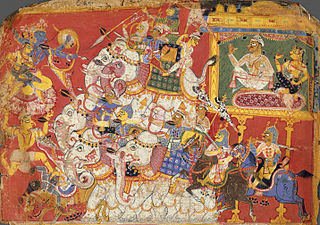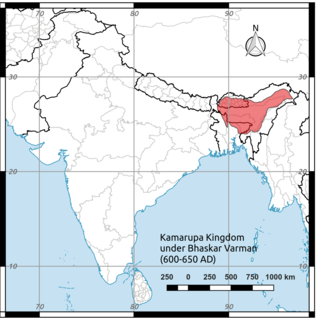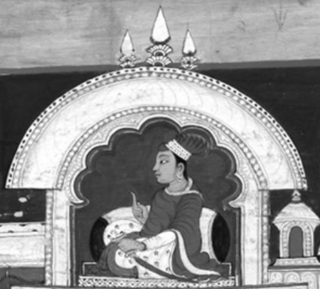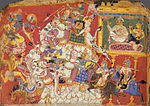
The Ahom dynasty (1228–1826) ruled the Ahom Kingdom in present-day Assam, India for nearly 598 years. The dynasty was established by Sukaphaa, a Shan prince of Mong Mao who came to Assam after crossing the Patkai mountains. The rule of this dynasty ended with the Burmese invasion of Assam and the subsequent annexation by the British East India Company following the Treaty of Yandabo in 1826.

The Kamakhya Temple at Nilachal hills in Guwahati, Assam is one of the oldest and most revered centres of Tantric practices, dedicated to the goddess Kamakhya. The temple is the center of the Kulachara Tantra Marga and the site of the Ambubachi Mela, an annual festival that celebrates the menstruation of the goddess. Structurally, the temple is dated to the 8th-9th century with many subsequent rebuildings—and the final hybrid architecture defines a local style called Nilachal. It is also one among the oldest 4 of the 51 pithas in the Shakta tradition. An obscure place of worship for much of history it became an important pilgrimage destination, especially for those from Bengal, in the 19th century during colonial rule.

Kamarupa, an early state during the Classical period on the Indian subcontinent, was the first historical kingdom of Assam.

Naraka, also known as Narakasura, is an asura king in Hindu mythology. In Assamese tradition, he is regarded as the legendary progenitor of all three dynasties of Pragjyotisha-Kamarupa, and the founding ruler of the legendary Bhauma dynasty of Pragjyotisha. Though the myths about Naraka are first mentioned in the Mahabharata, later texts embellish them. According to later post-Vedic texts such as the Brahma Purana and Vishnu Purana, he was the son of Bhudevi, fathered either by the Varaha incarnation of Vishnu or Hiranyaksha. He is claimed as one who established Pragjyotisha. He was killed by Krishna and Satyabhama. His son Bhagadatta—of Mahabharata fame—succeeded him.

The history of Assam is the history of a confluence of people from the east, west, south and the north; the confluence of the Austroasiatic, Tibeto-Burman (Sino-Tibetan), Tai and Indo-Aryan cultures. Although invaded over the centuries, it was never a vassal or a colony to an external power until the third Burmese invasion in 1821, and, subsequently, the British ingress into Assam in 1824 during the First Anglo-Burmese War.

The Varman dynasty (350–650) was the first historical dynasty of the Kamarupa kingdom. It was established by Pushyavarman, a contemporary of Samudragupta. The earlier Varmans were subordinates of the Gupta Empire, but as the power of the Guptas waned, Mahendravarman (470–494) performed two horse sacrifices and the status of Kamarupa as an independent state remained unimpaired. As per the Apsad Inscription of Adityasen, Susthivarman was defeated by Mahasengupta on the bank of Lauhitya. The first of the three Kamarupa dynasties, the Varmans were followed by the Mlechchha and then the Pala dynasties.

The Mlechchha dynasty ruled Kamarupa from their capital at Harruppesvar in present-day Tezpur, Assam, after the fall of the Varman dynasty. According to historical records, there were twenty one rulers in this dynasty, but the line is obscure and names of some intervening rulers are not known. Like all other Kamarupa dynasties a semi-mythical lineage from Narakasura was constructed to accord legitimacy to their rule. The Mlechchha dynasty in Kamarupa was followed by the Pala kings. The dynasty is unrelated to the previous Varman dynasty.

The Dimasa Kingdom was a late medieval/early modern kingdom in Assam, Northeast India ruled by Dimasa kings. The Dimasa kingdom and others that developed in the wake of the Kamarupa kingdom were examples of new states that emerged from indigenous communities in medieval Assam as a result of socio-political transformations in these communities. The British finally annexed the kingdom: the plains in 1832 and the hills in 1834. This kingdom gave its name to undivided Cachar district of colonial Assam. And after independence the undivided Cachar district was split into three districts in Assam: Dima Hasao district, Cachar district, Hailakandi district. The Ahom Buranjis called this kingdom Timisa.

The Bhauma dynasty is the second legendary dynasty of Pragjyotisha, after the Danava dynasty. Narakasura, who is said to have established this dynasty, and his descendants Bhagadatta and Vajradatta are first mentioned in the epics Mahabharata and the Ramayana in the sections that were composed in the first few centuries though they place them variously in either northwestern or eastern India. Narakasura's legend is further embellished in the locally composed Kalika Purana, the Yogini Tantra and local lores and the legends became firmly attached to Assam and North Bengal. The late embellishment of the Naraka legends point to legitimization of the three dynasties of the Kamarupa kings.
Though the precise Etymology of Assam, a state in India is unclear—there is general agreement that it is related to the Ahom people. Whatever the source of the English name, Assam is itself an anglicization.
Robert Bruce (1789–1824) was a Scottish arms trader and mercenary soldier on the north-east frontier of India. He took steps towards the introduction of tea plantations in Assam in the 1820s.

Bhaskaravarman was king of medieval Kamarupa and the last of the Varman dynasty. After being captured by the Gauda king during the reign of his father, he was able to re-establish the rule of the Varmans. He made political alliances with Harshavardhana of Thaneswar, against the alliance of the Gauda and East Malwa. He was visited by Xuanzang and Wang Xuance, the envoys of the Tang dynasty who have left accounts of the king and the kingdom.

Suklenmung(1539–1552) was a king of the Ahom kingdom in medieval Assam. Since he established his capital at Garhgaon, he is also called the Garhgaiya roja in the Buranjis. It was during his reign that Madhabdev and Sankardeva's son-in-law Hari were captured and Hari executed, which precipitated the departure of Sankardeva from the Ahom kingdom.

Sukhaamphaa also known as Khora roja (1552–1603) was a king of the Ahom kingdom of medieval Assam. He ruled for a period of fifty one years, the longest in the Ahom dynasty. Very fond of sports, he fell off an elephant soon after his ascension and the injury gave him a limp, and as a result the Buranjis often called him the Khora roja.

Purandar Singha was the last king of the Ahom kingdom in Assam. He was installed as king twice. The first time, he was installed by Ruchinath Burhagohain in 1818 CE, after the latter deposed Chandrakanta Singha from the throne. His first reign ended in 1819 CE, during the second Burmese invasion of Assam when his forces were defeated and the Burmese reinstalled Chandrakanta Singha on the throne. He along with Ruchinath Burhagohain continued their efforts to expel Burmese invaders, by seeking help from the British and through armed struggle. After First Anglo-Burmese War, the British East India Company took over Assam from the Burmese invaders. Finding it difficult to administer an unfamiliar region and sensing discontent among the local inhabitants to foreign rule, the British authorities decided to restore Upper Assam to a prince of Ahom Dynasty. Purander Singha was found suitable for this post and therefore, in April 1833 CE, except for Sadiya and Matak rajya, the entire territory of Upper Assam was formally made over to him, on the condition of yearly tribute of 50,000 rupees. Later, in 1838 CE, finding him incompetent and a defaulter in payments of revenue, the British formally annexed his kingdom, putting an end to a 600-year reign of the Ahom dynasty. When Purandar Singha accepted the position of Prince of Upper Assam, he did not realize the difficulties of the new position.

Sudangphaa (1397–1407) was the king of the Ahom kingdom. He was popularly known as Bamuni Konwar because of his upbringing in a Brahman's house. His reign marks the first stage in the growth of Hinduism in the Ahom dynasty. He initiated the Singarigharutha ceremony of the Ahom kings, a tradition which was followed by his successors.

Suteuphaa was the second king of Ahom kingdom who ruled from 1268 CE to 1281 CE. Suteuphaa succeeded his father Sukaphaa, who laid the foundation of Ahom kingdom in Assam. His reign was characterized by the expansion of his father’s kingdom. He also had conflicts with the Shans or Naras of Mungkang, a Shan kingdom in Upper Burma.
The following lists events that happened during 1501 in India.









